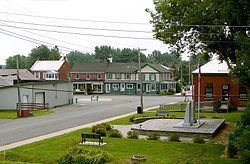Country Canada Settled 1785 Incorporated 1998 (South Glengarry) Local time Monday 8:21 PM | Province Ontario Incorporated 1792 (Royal Townships) Population 13,162 (2011) | |
 | ||
County Stormont, Dundas and Glengarry Weather 2°C, Wind NE at 3 km/h, 98% Humidity Points of interest Glengarry Campground, Cooper Marsh Conserva, St Raphael's Ruins, Cooper Marsh Visitor Ce | ||
South Glengarry is a township in eastern Ontario, Canada on the Saint Lawrence River in the United Counties of Stormont, Dundas and Glengarry.
Contents
Map of South Glengarry, ON, Canada
The township was created on 1 January 1998, by amalgamating the townships of Charlottenburgh and Lancaster with the independent village of Lancaster.
Communities
The township comprises the communities of Avondale, Bainsville, Bayview Estates, Bridge End, Brown House Corner, Camerons Point, Cashions Glen, Curry Hill, Dalhousie Mills, Glen Brook, Glendale Subdivision, Glen Falloch, Glen Nevis, Glen Norman, Glenroy, Glen Walter, Green Valley, Lancaster, Lancaster Heights, Loon Island, MacGillivrays Bridge, Martintown, Munroes Mills, North Branch, North Lancaster, North Lancaster Station, Pine Hill, Redwood Estates, South Lancaster, Summerstown, Summerstown Station, St. Raphaels, Tyotown, and Williamstown.
History
Charlottenburgh and Lancaster were two of the original eight "Royal Townships", established along the Saint Lawrence River in Upper Canada in the 1780s. This area was first settled by United Empire Loyalists. The development of this area was encouraged by Sir John Johnson, then the Superintendent General and Inspector General of Indian Affairs, who had been forced to abandon his land holdings in New York State during the American Revolution.
From the late 18th century to the early 19th century, the area was almost entirely settled by Scottish highlanders, especially from Inverness-shire, after the Highland Clearances. Canadian Gaelic / Scottish Gaelic had been spoken in Glengarry County since its first settlement in 1784.
Sir John built a house in Williamstown which was completed in 1785 and is now a Canadian National Historic Site, the Sir John Johnson Manor House. A grist mill and saw mill, now gone, were also built on the same location. Williamstown also has the oldest house in Ontario, The Bethune-Thompson House built in 1784. Occupants over the years have included the Reverend John Bethune (1751–1815), the great-great-grandfather of Doctor Norman Bethune, and David Thompson, Canadian explorer.
Some of the main partners of the North West Company, including Hugh McGillis, lived in this area.
Alexander McMartin, the first person born in Upper Canada to serve in the Legislative Assembly, was from Martintown.
The Glengarry Celtic Music Hall of Fame is located in Williamstown.
Williamstown is also home to Canada's oldest continuing annual fair, which celebrated its bicentennial in 2012. It is also quite possibly North America's oldest annual fair although this distinction has yet to be authenticated.
The Nor'Westers and Loyalist Museum is also located in Williamstown.
South Glengarry is the location of four National Historic Sites of Canada: the Bethune-Thompson House, the Glengarry Cairn, the Sir John Johnson House, and the ruins of St. Raphael's Roman Catholic Church.
St. Raphael's Catholic Church was built commencing 1821 under the authority of Alexander Macdonell later Bishop of Regiopolis (now Kingston, Ontario). This is one of the oldest churches in what was then the colony of Upper Canada. In late 1970, the church interiors, roof and tower were destroyed by fire, but the ruins were preserved. In 1973, a smaller church with the same name was built, attached to the ruins .
Sport
The Char-Lan Rebels of the Eastern Ontario Junior B Hockey League play out of the Char-Lan Recreation Centre in Williamstown.
Notable people
Culture
Canadian author Hugh Hood mentions Williamstown in his short story "Getting to Williamstown," first published in 1928.
